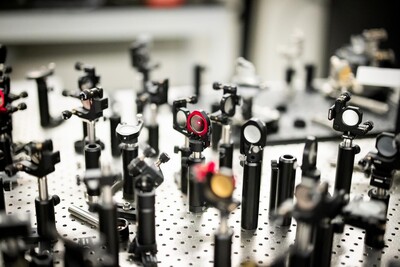Novel method paves the way for unhindered light guidance

Relaying a message from point A to B can be as simple as flashing a thumbs-up at a stranger in an intersection, signalling them to proceed — non-verbal, clear and universally understood. But light-based communication is rarely that straightforward.
Photons, tiny particles of light, are fragile and unpredictable. Unlike electrons, which must be conserved in circuits, photons can scatter, split, merge into different colours, or be absorbed, meaning that the number of photons in a system isn’t fixed, even while the energy they carry remains the same. This makes guiding them through fibre optics or photonic chips — optical mazes — far trickier than steering electrons through copper wires, because light signals can scatter into dead ends or vanish before reaching their destination.
Engineers often respond by refining every imperfection, polishing the maze to perfection. However, this approach can be exhausting and never fully addresses these limitations.
“What if, instead of fighting the flaws, you could change the rules of the maze itself — reshaping the landscape on the fly so light has no choice but to keep going forward,” said Bo Zhen, a physicist at Penn’s School of Arts & Sciences.
In a study published in Nature Nanotechnology, Zhen and his colleagues have built a ‘secret tunnel’ for photons that guarantees a beam can make it from A to B without getting stuck in traffic or lost along the way.
Their approach paves the way for chips that route light one-way around defects, optical isolators that don’t need bulky magnets and lasers that emit light only in a forward direction, immune to destabilising reflections. Robust photonic highways like these could reshape telecommunications, sensing and quantum technologies — fewer wrong turns, fewer detours and far less baggage.
The project started in 2018, when first author Li He proposed using polarised light on a photonic crystal, a semiconductor punctured with a regular array of holes, to create a stable topological state.
The aim was to reshape how light moves inside, forming a one-way path along the edges where light only travels forward. This ‘secret tunnel’, or chiral edge state, retains light’s one-way character despite small bumps or defects. Their theoretical proposal showed that photons could be shepherded much like electrons in exotic quantum materials.
“Back then, it was just equations; the math told us it was possible, but making it real meant designing the right material and driving it in just the right way. And theory doesn’t always agree with practice,” He said.
The experiment required two ultrafast lasers — one to drive the crystal and one to probe it — which Zhen ordered from Europe at the start of 2020, just as COVID-19 closures tightened borders and throttled supply chains. With help from collaborators at University of California Santa Barbara, they had a stable device by 2022.
Their work showed that with linear polarisation, the crystal stayed gapless, its internal bands crossing like indifferent pedestrians. With circular polarisation, the bands twisted open a full gap, marked by the unmistakable topological signature: a Chern number of one (C=1), a distinct characteristic indicating an open one-way channel.
From their laser spectra — detailed energy footprints — the team reconstructed the band structure, confirming they had pushed the system such that the crystal was rhythmically driven in time, creating new protected routes within the energy gaps.
“It was a Eureka moment — the plots on our screen matched the topological band diagram we had dreamed about. Suddenly, this wasn’t just a route on a map; we were walking the road,” He said.
In nonlinear optical material, two photons of one colour can merge into a single photon of a different colour, or a single photon can split into several. “Pump in one blue photon, watch two red photons come out — connections and transfers that electronics simply don’t allow,” Zhen said. “That freedom means photonic systems aren’t bound by the same constraints as electronics, and this new topological phase of light hands over a fresh rulebook for device design.”
Zhen said the team is pushing the concept into three-dimensional crystals, scaling it to microwave frequencies where components are larger and easier to handle and exploring whether the effect can shelter fragile quantum states of light.
“We’ve shown it’s possible. Now the goal is to see whether this approach can protect quantum information or create new classes of optical devices,” Zhen said.
Transforming acoustic waves with a chip
Researchers have developed a chip that uses on-chip phased interdigital metamaterials to shape...
Mechanical strain boosts lead-free ferroelectrics
Scientists have discovered a way to boost the performance of lead-free ferroelectrics using pure...
Crypto chip keeps water flowing in rural communities
Twisthink has integrated Microchip's ATECC608B crypto chip into an IoT pump sensor, to...






